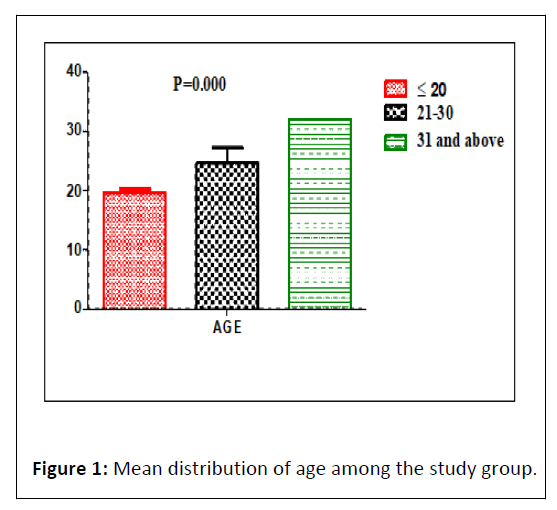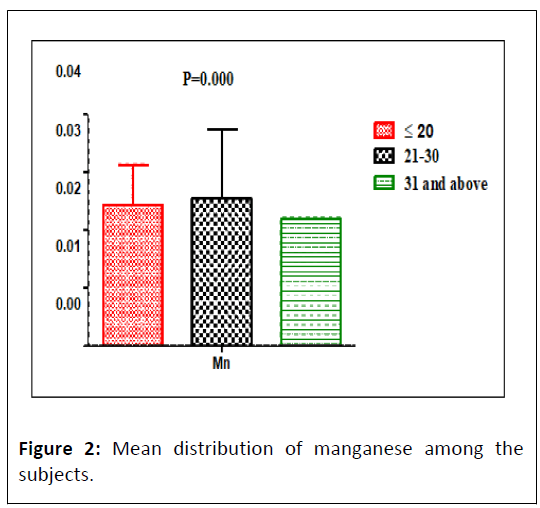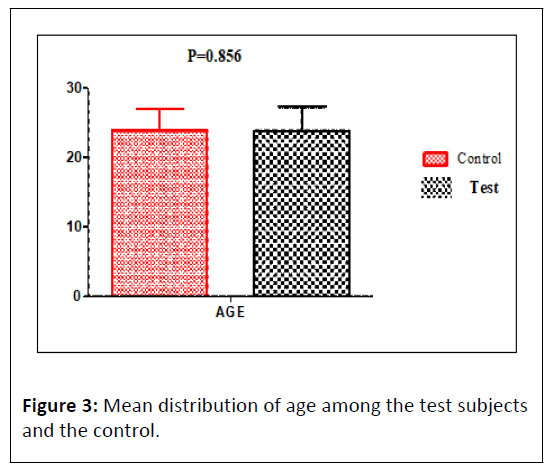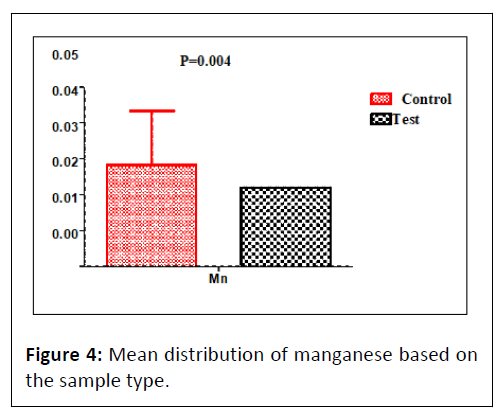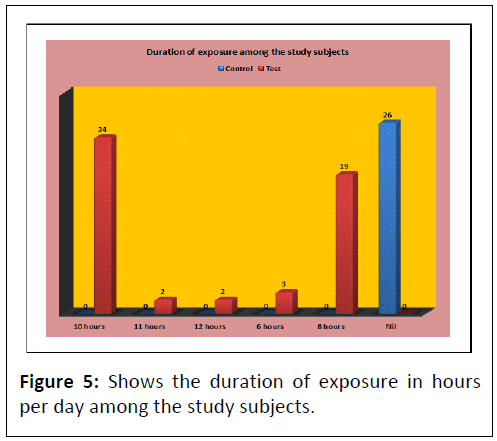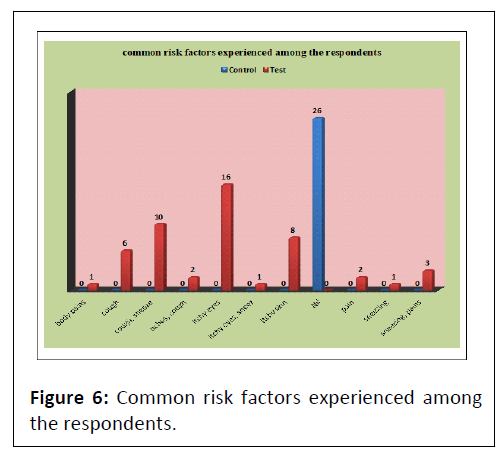Assessment of Serum Lead, Cadmium and Manganese in Male Sawmillers within Ekpoma and its Environs
Otiti Iyegbekosa
Department of Chemical Pathology, Faculty of Medical Laboratory Science, Ambrose Alli University, Ekpoma, Nigeria
Published Date: 2023-05-08DOI10.36648/2572-5483.8.3.187
Otiti Iyegbekosa1*, Taiwo Christopher Awoyemi2and Eidangbe Adesuwa1
1Department of Chemical Pathology, Faculty of Medical Laboratory Science, Ambrose Alli University, Ekpoma, Nigeria
2Department of Clinical Chemistry, Covenant University Medical Centre, Ota, Nigeria
- *Corresponding Author:
- Otiti Iyegbekosa
Department of Chemical Pathology,
Faculty of Medical Laboratory Science, Ambrose Alli University, Ekpoma,
Nigeria,
E-mail: Otitilizzy@yahoo.com
Received date: April 04, 2023, Manuscript No. IPJPM-23-16161; Editor assigned date: April 06, 2023, PreQC No. IPJPM-23-16161 (PQ); Reviewed date: April 20, 2023, QC No. IPJPM-23-16161; Revised date: April 27, 2023, Manuscript No. IPJPM-23-16161 (R); Published date: June 08, 2023, DOI: 10.36648/2572-5483.8.3.187
Citation: Iyegbekosa O, Awoyemi TC, Adesuwa E (2023) Assessment of Serum Lead, Cadmium and Manganese in Male Sawmillers within Ekpoma and its Environs. J Prev Med Vol.8 No.3:187
Abstract
Woods are preserved by chemicals some of which are heavy metals that poise a serious threat to health when ingested even in small concentrations. In developing regions of Nigeria, occupations such as sawmilling are common among the male folks thereby raising the risk of their exposure to heavy metals via inhalation of sawdust particles, a byproduct of wood processing. The aim of this study was to assess the serum Lead (Pb), Cadmium (Cd) and Manganese (Mn) of male sawmillers within Ekpoma and its environs, analysis was done using the method of Atomic Absorption Spectrometry (AAS). A total of 100 apparently healthy male subjects were recruited for this study, 50 subjects who were sawmillers served as the test while the other 50 served as the control, the levels of Cadmium (Cd) and Lead (Pb) were below detectable values, the serum level of manganese was significantly higher (0.03 ± 0.00) among age group of 21-30 years compared to the mean (0.02 ± 0.00) among ≤ 20 years and (0.02 ± 0.00) among 31 years and above, p<0.05 was considered as level of significance. A significant reduction in the mean age was observed among age group of ≤ 20 (19.63 ± 0.16) compared to (24.65 ± 0.29) among 21-30 years and (32.00 ± 0.00) among 31 and above. Based on sample type, no significant increase was observed in the mean distribution of age (23.90 ± 0.43) among the control subjects compared with (23.78 ± 0.50) among the test subjects. A significant increase was observed in the mean manganese (0.003 ± 0.00) among the control subjects compared to the mean manganese (0.02 ± 0.00) among the test subjects. From this study, occupational exposure to heavy metals affirms a detrimental effect to the body.
Keywords
Sawmill; Lead; Cadmium; Manganese
Introduction
Work is essential to people’s lives and it is a sine qua non to the survival of the family and society. The level of risk or danger that is posed by work-related activities and policies is known as an occupational hazard [1]. A sawmill is a place where timbers are sawn by a machine into different sizes of planks or board, while sawmillers refers to individuals operating a sawmill [2]. There are several hazards in the sawmill industry, one of which is dust [3]. When woods are processed through milling, drilling or crushing, the heavy metals together with the wood dust are released into the work environment and inhalation or involuntary ingestion of the wood dust over a period, may result in bioaccumulation of the heavy metals, which may further result in an increased bioavailability (elevated serum concentration of the heavy metals), which in turn, may cause toxicity to the kidney, liver and other organs of the body [4]. It is estimated that at least 2 million people are routinely exposed occupationally to wood dust worldwide.
Saw dust is a by-product of wood processing and the sizes of saw dust particles generated largely depend on the activities from which they are produced [5]. The main subjects of saw dust exposure which also happens to be the oldest form of occupational exposure are sawmill workers and carpenters [6] with the potential of inducing nephrotoxicity and other health conditions [3].
In developing regions of Nigeria, occupations such as sawmilling and carpentry are common among the male folks thereby raising the risk of their exposure to heavy metals. Sawmill workers may ingest unsafe levels of trace elements over time which will accumulate in various tissues and organs, eventually causing damage, as studies have shown that accumulation of potentially toxic heavy metals in the body pose health threat to their consumers especially humans [7]. The sawmill an industry in Ekpoma is generally made up of several small scale privately owned sawmill industries with little or no safety monitoring. Most disturbing is the lack of workplace regulations for environmental pollutant exposure in Nigeria and the utter disregard for workshop ethics and environmental protection laws by the sawmillers. Sawing of dry wood generates great amount of inhalable saw dust particles which is closely associated with nasal cancer and occupational asthma resulting from exposure to saw dust in the sawmilling industry [8]. Wood dust particularly from hardwood has a carcinogenic effect on the nasal cavity, paranasal sinus and nasopharynx [9]. The common respiratory complaint among wood workers due to dust exposure includes cough, dyspnea, eye irritation, sneezing and rhinitis [1,5,10]. Heavy metals are naturally occurring elements with a relatively high atomic mass and density, as well as a high potential for biological harm [11]. A comparison of trace elements and heavy metals revealed that the majority of heavy metals known to man are trace elements, some with known and others with unknown biological [12]. It can thus be concluded that while not all trace elements are heavy metals, the majority of heavy metals are trace elements.
Generally, humans are exposed to heavy metals through contaminated foods, sea animals, drinking water and occupational exposure to dust fumes (polluted air) during work [12]. Heavy metals are hazardous due to their bioaccumulative properties and non-degradability. Preservation of woods is by certain chemicals, some of which are heavy metals such as Cadmium (Cd), Lead (Pb) and Manganese (Mn). Few studies have shown elevated concentration levels of some heavy metals including Lead (Pb), Cadmium (Cd), Chromium (Cr), Barium (Br), Arsenic (As) and Mercury (Hg) in saw dust particles, the concentration of these elements in dust particles exceeded permissible occupational exposure limits for an 8-hour workdays [8,13]. This implies that sawdust particles constitute serious environmental health risk not only to the workers in these mills but to the general environment since dust particles with such elevated levels of metals have the capacity to contaminate air, soil and surface water bodies in the vicinity of such facilities. Thus this study was conducted to assess serum Lead (Pb), Cadium (Cd) and Manganese (Mn) in male’s sawmillers within Ekpoma and its environs. The serum levels of theses heavy metals (Pb, Cd and Mn) may or may not be elevated in blood serum but are most likely to be deposited in various tissues and organs of the body.
Materials and Methods
Study area
The study area for this research project was Ekpoma, a town located in Edo sate, Nigeria. The geographical location of Ekpoma is 6°45’N 6°08’E of latitude. It is the administrative headquarters of the Esan West Local Government Area in Edo State. Ekpoma has a population of over 190,000 people, an adult male population of over 60,000 and an adult female population of over 50,000. The people in Ekpoma are mainly of the Esan tribe and are predominantly academic and non-academic staffs of Ambrose Alli University (AAU), traders, owners of small businesses, motorcyclists, subsistence farmers, mechanics, sawmillers and others including civil service. Traditionally, Esan people in Ekpoma are trado-medical practitioners and agriculturalist who cultivate palm trees, cocoyam, cassava, maize, fruits and various vegetables.
Study population/Sample size
Ekpoma has a total population of about 190,000 people and an adult male population of about 60,000 people. In this study, the subjects include male sawmillers and control subjects. 15 sawmills with each having an average number of 8 workers per sawmill were visited and a total of 100 samples was obtained for the study.
The sample size was calculated using the formula N=(Z² pq) ÷ D² (Araoye, 2004).
Where N=The desired sample size (when population is greater than 10,000), Z=Is a constant given as 1.96 (or more simply at 2.0) which compounds to the 95% confidence level, P=Expected prevalence, q=1.0–p, D=Acceptable error 5%.
N=(1.96)² × 0.07 × (1-0.07)] ÷ (0.05)²
N=100.034
When the above formula was used, a sample size of 100 was obtained.
Research Design
This research was designed to assess the serum Lead (Pb), Cadmium (Cd) and Manganese (Mn) in male sawmillers within Ekpoma. A total of 100 apparently healthy male subjects within the ages of 18 to 40 years were recruited for this study. Fifty (50) subjects were non-sawmillers or non-wood workers while the other fifty (50) subjects were sawmillers who work at different locations in Ekpoma (mousco, opoji and ujoelen sawmills) with a minimum of six (6) months occupational exposure. The fifty (50) subjects who were non-sawmillers or non-wood workers served as control while the other fifty (50) served as the test subjects. A random sampling technique was employed to select suitable participants in each of the workshops. The control subjects were selected from those working or residing within the study areas but were not exposed to wood dusts or heavy metals.
Personal data of each participant was obtained through a questionnaire administered by a trained person. The questionnaire considered the socio-demographic characteristics (age, sex, education and income), work history (number of working years and daily hours of duty), hazards (heat, noise, dust and vibration), smoking status, awareness and use of PPE and hygiene practices (hand washing, bathing and changing of clothes at close of work) among the test subjects.
Informed Consent
Chairmen of the selected sawmill industries were approached and the purpose of the study was explained to them who in turn assisted to mobilize and disseminate the information to saw millers. Only the individuals that are willing to participate and whose informed consent was obtained were recruited for this study. They were provided with enough information about the purpose of the research and the expected outcome of the investigation.
A written consent form was given to all participants for signatures of consent.
Inclusion criteria
All test subjects were apparently healthy sawmillers with at least minimum of six (6) months occupational exposure. All control subjects were also apparently healthy individuals.
Exclusion criteria
Subjects who are exposed to burning woods daily in their surroundings, or those using firewood as a source of heat energy for cooking were excluded.
Sample collection
With the aid of hypodermic syringes and needles, random blood samples was collected asceptically from willing participants during their routine working hours, venous blood samples of about 5 ml was collected from the antecubital vein of each participants into tubes void of anticoagulants (plain tubes) and spun. The serum obtained was used in the analysis Lead (Pb), Cadmium (Cd) and Manganese (Mn) using the Atomic Absorption Spectrophotometer (AAS).
Laboratory Analysis
Principle and methodology
Serum levels of Lead (Pb), Cadmium (Cd) and Manganese (Mn) were analysed using the method of Atomic Absorption Spectrometry (AAS).
Serum levels of Lead (Pb), Cadmium (Cd) and Manganese (Mn) were determined with flame Atomic Absorption Spectrophotometer (AAS) using a direct method as described by (Arinola and Akiibinu, 2006). The method is based on the principle that atoms of the element when aspirated into AAS vaporized and absorbed light of the same wavelength as that emitted by the element when in the excited state.
Procedure
1 mL of serum sample was transferred into a conical flask. 5 mL of 3:1 Nitric acid per chloric acid was added to each serum sample. The samples were transferred to a hot plate for digestion by heat for a period of 30 minutes to 1 hour. When dense white fume occurred, the heating continued until a colorless solution was obtained. This was necessary to break down the serum samples so that the heavy metal ion can exist freely thereby making it detectable by the AAS. It was transferred into a 100 ml volumetric flask and rinsed five times with distilled water. The filtrates were analyzed for heavy metals using Atomic Absorption Spectrophotometer (AAS) at a wavelength specific for each heavy metal.
Statistical analysis
The statistical analysis was done using IBM Statistical Package for the Science Solution (SPSS) version 25.0 software package and graph pad prism 5.0 to determine the mean, standard error of mean, correlations and one way Analysis of Variance (ANOVA) among study groups P˂0.05 was considered as level of significance.
Results
Figure 1 shows the mean distribution of age among the study group, in the figure a significant reduction in the mean age was observed among age group of ≤ 20 (19.63 ± 0.16) compared to (24.65 ± 0.29) among 21-30 years and (32.00 ± 0.00) among 31 and above as p<0.05.
Figure 2 shows the mean distribution of manganese among the study group, in the figure the increased mean manganese (0.03 ± 0.00) among age group of 21-30 was significant compared to the mean (0.02 ± 0.00) among ≤ 20 years and (0.02 ± 0.00) among 31 and above as p<0.05.
Figure 3 shows the distribution of age based on the sample type, in the figure no significant increase was observed in the mean age (23.90 ± 0.43) among the control subjects compared to the mean (23.78 ± 0.50) among the test subjects as p<0.05.
Figure 4 shows the mean distribution of manganese based on the sample type, in the Figure 5 a significant increase was observed in the mean manganese (0.03 ± 0.00) among the control subjects compared to the mean (0.02 ± 0.00) among the test subjects as p<0.05. Table 1 shows the duration of exposure to heavy metals among subjects.
| Control | Test | |
|---|---|---|
| 1 year | 0 | 1 |
| 10 months | 0 | 1 |
| 10 years | 0 | 1 |
| 11 months | 0 | 1 |
| 11 years | 0 | 1 |
| 12 years | 0 | 1 |
| 2 year | 0 | 1 |
| 20 years | 0 | 1 |
| 28 years | 0 | 1 |
| 3 year | 0 | 1 |
| 4 year | 0 | 1 |
| 4 years | 0 | 3 |
| 5 year | 0 | 1 |
| 6 months | 0 | 24 |
| 6 years | 0 | 3 |
| 7 months | 0 | 1 |
| 7 year | 0 | 1 |
| 8 months | 0 | 4 |
| 8 years | 0 | 2 |
| Nil | 26 | 0 |
Table 1: Duration of exposure toxic metals among the subjects.
Figure 6 shows the common risk factors experienced by the respondents. Itchy eyes, coughing and sneezing were common among the respondents. 66.67% of the test subjects suffered itching and irritation in the eyes while 41.67% suffered frequent cough and sneezing is given by Table 2.
| Sample Type | |||
|---|---|---|---|
| Control | Test | Total | |
| Experience | 24 | 0 | 24 |
| Body Pains | 0 | 1 | 1 |
| Cough | 0 | 6 | 6 |
| Cough sneeze | 0 | 10 | 10 |
| Itches, Cough | 0 | 2 | 2 |
| Itches, Eyes | 0 | 16 | 16 |
| Itches eyes, Sneeze | 0 | 1 | 1 |
| Itchy skin | 0 | 8 | 8 |
| Nil | 26 | 0 | 26 |
| Pain | 0 | 2 | 2 |
| Sneezing | 0 | 1 | 1 |
| Sneezing, pains | 0 | 3 | 3 |
| Total | 50 | 50 | 100 |
Table 2: Shows the experience and sample type cross tabulation.
Discussion
Occupational workers especially those working in industries associated with metal and mining activities are excessively exposed to many toxic metals, which affect them. This study was conducted to determine the serum Lead (Pb), Cadmium (Cd) and Manganese (Mn) in male sawmillers within Ekpoma and its environs, in this study Analysis of Variance (ANOVA) (p<0.05) revealed that there is no significant difference in the mean concentration of lead among the sawmillers and the control subjects, significant variability exists with respect to age of the subjects. Data represented in Figure 6 shows the common risk factors experienced by the respondents. 66.67% of the test subjects suffered itching in the eyes while 41.67% suffered frequent cough and sneezing due to inhalation of saw dust, which could lead to reduced respiratory functions. This corroborates with the findings of [14]. The concentrations of manganese shows a significant reduction with increased in age of the subject this findings also corroborate with the submission of [8] who also reported similar outcome in a study on trace elements in sawdust particles in the vicinity of sawmill in Sapele, Nigeria, however there is paucity of information in relation to heavy metals among sawmill workers, but some related occupational exposure among blacksmith in Nigeria revealed that metals concentrations had a descending order of concentration as follows: Zn>Pb>Cd>Cr which increased with increase with age and exposure rates and were found to be statistically different between blacksmiths and control. In this study serum determination of Lead and Cadmium were not detectable in both control and the test subjects. The significant increase in manganese among the test subjects compared to the control is attributed to increase in the exposure to risk factors associated with nature of the workers as more than two third of the subjects indicate prolong risks of exposure to the heavy metals, also the working hours among the test subjects is more prolonged as compared to the control subjects.
Conclusion
Heavy metals are naturally occurring elements which are extremely dangerous to human health when present even in small concentrations; woods are preserved by certain chemicals among which are heavy metals. The data presented in this study shows that occupational exposure to heavy metals affirms a detrimental effect to the body. Workers in the sawmill are occupationally exposed to heavy metals usually through the inhalation of wood dust. Due to the bioaccumulative activity of these metals, they tend to easily deposit in tissues which can Lead to damage to certain organs such as the brain and kidney, acute pulmonary edema and irreversible diseases. Therefore, workers in the sawmilling industry are advised to operate under standard conditions.
Recommendation
Heavy metals such as Lead (Pb), Cadmium (Cd) and Manganese (Mn) gain entrance into the body mainly via inhalation and ingestion; it is therefore recommended that workers in the saw mill industry should operate under standard conditions in order to reduce the risk of possible inhalation and ingestion of these substances to the barest minimum. Personal Protective Equipment (PPE) such as protective gloves, nose masks and protective coats should be worn during working hours. Workers in the sawmill are also encouraged to observe hygienic practices such as hand washing, bathing and changing of clothes after working hours. To give credence to this work, further experimental studies should be carried out on the tissues rather than the blood as concentration of heavy metals in blood are only elevated for a short time after which they rapidly disappear into tissues due to their high affinity for tissue protein.
Data Availability
The data used to support the findings of this study are included within the article.
Ethical Approval
Ethical approval for the study was obtained from the ethical review commitee, Ambrose Alli University Ekpoma, Edo state, Nigeria.
Conflicts of Interest
The authors declare that there is no conflict of interest.
Authors Contributions
Conceptualization and supervision of the research was done by Eidangbe Adesuwa, Iyegbekosa Otiti collected samples and data needed for the research and performed analysis, Taiwo Christopher Awoyemi assisted with the analysis and writing the review.
Acknowledgement
The author team is grateful to Engr. Charles Otiti for financial provision and to Eidangbe Adesuwa for moral support and supervision of the whole research process.
References
- Agbana BE, Joshua AO, Daikwo MA, Metiboba LO (2016) Knowledge of occupational hazards among sawmills workers in Kwara state, Nigeria. Niger Postgrad Med J 23: 25-32.
[Crossref], [Google scholar], [Indexed]
- Johnson OE, Umoren QM (2018) Occupational hazards and health problems reported by workers in a sawmill in Uyo, Nigeria. J Environ Occup Sci 7: 17-24.
[Crossref], [Google scholar]
- Labrèche F, Duguay P, Ostiguy C, Boucher A, Roberge B, et al. (2013) Estimating occupational exposure to carcinogens in Quebec. Am J Ind Med 56: 1040-1050.
[Crossref], [Google scholar], [Indexed]
- Morais S, Costa FG, Pereira ML (2012) Heavy metals and human health. Environmental health-emerging issues and practice, Prof. Jacques Oosthuizen (Ed.) Rijeka, Croatia.
[Crossref], [Google scholar]
- Adeoye OA, Adeomi AA, Adewole AO, Israel OK, Temitayo-Oboh AO, et al. (2014) Wood dust particles: Environmental pollutants in Nigerian sawmill industries. J Environ Occup Sci 3: 77–80.
- Deshpande A, Afshan A (2014) Effect of chronic exposure of sawdust in workers employed in sawmills: A cross-sectional study. J Appl Med Sci 2 (4A): 1202-1205.
- Ali H, Khan E, Ilahi I (2019) Environmental chemistry and ecotoxicology of hazardous heavy metals: Environmental persistence, toxicity and bioaccumulation. Journ Chem 5: 1-5.
[Crossref], [Google scholar]
- Nwajei GE, Iwegbue CM (2007) Trace elements in sawdust particles in the vicinity of sawmill in Sapele, Nigeria. Pak J Biol Sci 10: 4311-4314.
[Crossref], [Google scholar], [Indexed]
- Alonso-Sardón M, Chamorro AJ, Hernández-García I, Iglesias-de-Sena H, Martín-Rodero H, et al. (2015) Association between occupational exposure to wood dust and cancer: A systematic review and meta-analysis. PloS One 10: e0133024.
[Crossref], [Google scholar], [Indexed]
- Osuchukwu NC, Osuchukwu EC, Eko JE, Otareh OO (2015) Occupational exposure to wood dust in Calabar municipality, Cross River State, Nigeria. Int J Sci Res 4: 1414–1420.
- Duffus JH (2002) Heavy metals‘-A meaningless term? IUPAC. Pure Appl Chem 74: 793-807.
[Crossref], [Google scholar]
- Ming-Ho Y, Tsunoda H, Tsunoda M (2005) Environmental toxicology: Biological and health effects of pollutants. (3rd edn) CRC Press, Boca Raton, USA.
- Krolak E (2000) Heavy metals in fall dust in Eastern Mazowieckie Province. Pol J Environ Stud 9: 517-522.
- Mahjoub AA (2021) Occupational exposure to saw dust and its effects on the respiratory system of wood workshops workers, at omdurman industrial area.
Open Access Journals
- Aquaculture & Veterinary Science
- Chemistry & Chemical Sciences
- Clinical Sciences
- Engineering
- General Science
- Genetics & Molecular Biology
- Health Care & Nursing
- Immunology & Microbiology
- Materials Science
- Mathematics & Physics
- Medical Sciences
- Neurology & Psychiatry
- Oncology & Cancer Science
- Pharmaceutical Sciences
